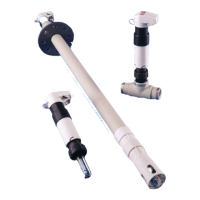13
4 CALIBRATION
4.1 Method
When the electrode system has been correctly connected and
all electrical connections made to the associated pH analyzer,
the system is ready for calibration by immersing the sensor
(using suitably sized beakers) either:
a) in a calibration solution (buffer) of known pH value for a
single-point calibration,
or
b) in two separate calibration solutions of known pH values
for a two-point calibration.
For sensors already in use:
1) Remove the electrode from the process or sample.
2) Wash the visible electrode surface with demineralised
water.
3) Proceed as described in the paragraph above.
To have agreement with a measured sample, there may be times
when a process calibration is necessary.
1) Perform a buffer calibration.
2) Ensure that the electrode is returned to the process for at
least 10 minutes before performing a process
calibration.
3) To mimimize solution temperature effects, measure the
sample at the same temperature as the process.
Refer to the instruction manual for the pH analyzer for full details
of the calibration procedures.
Warning. Close all isolating valves before removing an
electrode from a flow line.
°C0 01025203040506070809
Hp
4 00.400.400.410.410.430.450.480.421.461.412.4
7 11.760.710.700.789.679.679.679.699.630.780.7
9 84.953.932.981.931.950.989.839.809.888.848.8
Table 4.1 Recommended Buffer Solutions
4.3 Redox (ORP Sensor)
When the sensor has been correctly connected and all electrical
connections have been made to the associated Redox (ORP)
analyzer, it is ready for calibrating. Follow the calibration
procedure in the analyzer User Guide.
For sensors that are connected to analyzers that do not have
Redox (ORP) sensor calibration capabilities, it is possible to
check the response as follows:
1) Prepare standard 4 and 7 pH buffer solutions. Add one
gramme (heaped spatula) of analar quinhydrone to
100 ml (3.5 Flu oz.) of each buffer solution. Let them
stand for 30 minutes.
2) Immerse the sensor in each solution in turn and note the
mV value when stable.
The values obtained should be within ±15 mV of the following:
pH Buffer mV
4 +259
7 +82
noituloSreffuB.oNtraP
etalahthpnegordyhmuissatopM50.0Hp40110040
muissatoponom/etahpsohpnegordyhmuidosiDHp7
ximetahpsohpnegordyhid
0210040
xarobM50.0Hp90310040
Table 4.2 Buffer pH Value / Temperature (°C)
4.2 Buffer Solutions
Recommended buffer solutions are shown in Table 4.1.
Notes.
• Ensure that the visible surface of the electrode has
been cleaned using demineralized water.
• When moving from one buffer solution to the next,
wash the electrode using demineralized water and
dry it carefully using a soft tissue.
Table 4.2 shows the change in pH value that occurs with a
change in the temperature of the recommended 4, 7, and 9 pH
buffer solutions.

